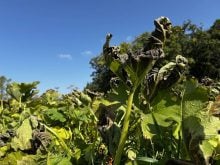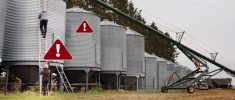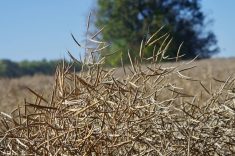Manitoba farmers aren’t giving up on the 2019 crop yet despite an especially wet September which, for the second consecutive year, has delayed harvest.
“We’ve had very few calls from producers who have concluded their crop is in a spot where they can’t harvest it, or it’s not going to be worth harvesting,” David Van Deynze, Manitoba Agricultural Service Corporation’s vice-president of insurance operations said in an interview Sept. 30.
Read Also

Local farm businesses, groups look forward to Manitoba Ag Days 2026
Most of agriculture is seemingly at Manitoba Ag Days each January: Manitoba agribusinesses and farm groups look forward to connecting with farmers at the 2026 show.
About a third of Manitoba’s crop was still in the field, Manitoba Agriculture said in its weekly crop report Oct. 1. That’s up from the three-year average of 24 per cent unharvested as of the first week of October.
Most of agro-Manitoba received rain during the last week of September with amounts ranging from as high as 40 to 70 mm in the east to 16 to 30 mm in the Interlake.
Environment Canada says Winnipeg received 153.1 mm of rain last month, coming close to matching the 137-year-old record of 156.2 mm set in 1872.
The Miami area received 165 mm over 10 days — Sept. 20 to 30.
The wet weather is causing unharvested wheat to sprout and bleach, resulting in lower grades, Manitoba Agriculture says.
Some swathed canola crops are sprouting too.
Why it matters: The weather’s slowed combining, but at least so far the province’s farmers think this crop is still worth harvesting.
Despite the harvest delay there’s still time to get this year’s crop in the bin, Van Deynze said.
Things were looking bleak the same time last year.
“We didn’t get as much rain (last year), but I think we had rain on a similar number of days,” he said.
“In the end, if I remember correctly, producers were able to start harvesting in August and really barely turned a wheel in most of September and then in October things straightened out for them again. With any luck something like that will happen again this year and producers will have a window to get their crop off.”
Almost every year some Manitoba crop doesn’t get harvested until spring.
Farmers seed expecting to harvest and are tenacious about getting the crop off, Van Deynze said.
“We’re well aware as to how resilient farmers are and how they do their best in all situations,” he added. “Usually we (MASC) are the last resort when they have tried everything they can.”
Agriculture Minister Ralph Eichler said the same when talking to reporters Sept. 30.
“They (farmers) find ways to get the crop off and certainly we hope that they do,” he said. “But we also know that we have to have programs in place for them to make sure they are stable and functional long term and short term.”
In addition to crop insurance (AgriInsurance), farmers who suffer from substantial drops in revenue can sometimes offset some of it through AgriStability and AgriInvest.
However, farmers across Canada complain AgriStability, a federal-provincial program, doesn’t offer much aid since the former Conservative government cut the payout trigger to a drop of 70 per cent or less in margins from the original 85 per cent.
Farm groups have been pushing during the federal election campaign to restore it to 85 per cent drop.
Meanwhile, farmers who can’t harvest their crop, or they don’t think it’s worth harvesting, need to call MASC before destroying, baling or feeding it, Van Deynze stressed.
“That’s the key point.”
MASC will estimate how much crop, if any, it believes can be harvested. Based on that the farmer can decide whether to harvest or destroy it.
If what the farmer harvests is less than what MASC estimated, compensation is based on what was harvested, Van Deynze said.
In addition to insuring a certain amount of crop production, coverage includes a grade guarantee for almost all crops. That means in some cases when yields aren’t low enough to trigger a crop insurance payout, a payment is made because the grade is so low.
For example, the grade guarantee for red spring wheat is No. 2, 13.5 per cent protein. Say a farmer harvested 50 bushels an acre, which was above his or her coverage, but it graded feed. MASC would calculate the percentage difference between feed and No. 2, 13.5 per cent protein.
If feed wheat is worth 80 per cent of No. 2, 13.5, the farmer’s wheat yield would be adjusted to 40 bushels an acre (50 bushes X 80% = 40 bushels), which, depending on coverage, could trigger a payout.
“These are tough years because generally speaking, especially with cereals crops, the bushels are there, it’s how badly sprouted are they, or whatever the case may be,” Van Deynze said. “It’s a challenge and a difficult situation for producers for sure.”
Despite harvest delays last September, which followed a drier-than-normal growing season, Manitoba farmers, on average, harvested a good crop in 2018. As a result, crop insurance had a good year too with payouts totalling $96.2 million on 5,243 claims. MASC collected far more in premiums.
“There certainly were some claims and some areas had some struggles (in 2018), but overall it was a very good year,” Van Deynze said in a March interview.
More than 8,000 Manitoba farms are enrolled in AgriInsurance, a federal-provincial program administered by MASC.
The two governments were expected to contribute $125.07 million in premiums this year.
Manitoba has the highest level of AgriInsurance participation in Canada with more than 90 per cent of annual crop acres enrolled.
Under AgriInsurance, premiums for most programs are shared 40 per cent by participating producers, 36 per cent by the Government of Canada and 24 per cent by the Manitoba government.
Administrative expenses are paid 60 per cent by Canada and 40 per cent by Manitoba.
















